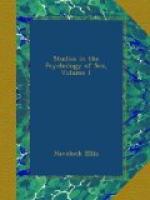[111] Sir W.F. Wade, however, remarked, some years ago, in his Ingleby Lectures (Lancet, June 5, 1886): “It is far from exceptional to find that there is an extreme enhancement of concupiscence in the immediate precatamenial period,” and adds, “I am satisfied that evidence is obtainable that in some instances, ardor is at its maximum during the actual period, and suspect that cases occur in which it is almost, if not entirely, limited to that time.” Long ago, however, the genius of Haller had noted the same fact. More recently, Icard (La Femme, Chapter VI and elsewhere, e.g., p. 125) has brought forward much evidence in confirmation of this view. It may be added that there is considerable significance in the fact that the erotic hallucinations, which are not infrequently experienced by women under the influence of nitrous oxide gas, are more likely to appear at the monthly period than at any other time. (D.W. Buxton, Anesthetics, 1892, p. 61.)
[112] Gehrung considers that in healthy young girls amorous sensations are normal during menstruation, and in some women persist, during this period, throughout life. More usually, however, as menstrual period after menstrual period recurs, without the natural interruption of pregnancy, the feeling abates, and gives place to sensations of discomfort or pain. He ascribes this to the vital tissues being sapped of more blood than can be replaced in the intervals. “The vital powers, being thus kept in abeyance, the amative sensations are either not developed, or destroyed. This, superadded by the usual moral and religious teachings, is amply sufficient, by degrees, to extinguish or prevent such feelings with the great majority. The sequestration as ‘unclean,’ of women during their catamenial period, as practiced in olden times, had the same tendency.” (E.C. Gehrung, “The Status of Menstruation,” Transactions American Gynecology Society, 1901, p. 48.)
[113] It is possible there may be an element of truth in this belief. Diday, of Lyons, found that chronic urethorrhoea is an occasional result of intercourse during menstruation. Raciborski (Traite de la Menstruation, 1868, p. 12), who also paid attention to this point, while confirming Diday, came to the conclusion that some special conditions must be present on one or both sides.
[114] See, e.g., Ballantyne, “Teratogenesis,” Transactions of the Edinburgh Obstetrical Society, 1896, vol. xxi, pp. 324-25.
[115] As quoted by Icard, La Femme, etc., p. 194. I have not been able to see Negrier’s work.
[116] I deal with the question of sexual anaesthesia in women in the third volume of these Studies: “The Sexual Impulse in Women.”
II.
The Question of a Monthly Sexual Cycle in Men—The Earliest Suggestions of a General Physiological Cycle in Men—Periodicity in Disease—Insanity, Heart Disease, etc.—The Alleged Twenty-three Days’ Cycle—The Physiological Periodicity of Seminal Emissions during Sleep—Original Observations—Fortnightly and Weekly Rhythms.




